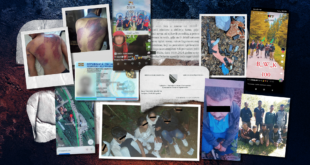KABUL, Afghanistan – A suicide bomber boarded a police bus just after a woman and her two children got on, setting off a blast Tuesday that blew the roof off the bus and killed at least 12 people, including several children, officials and witnesses said.
The explosion — the second such attack in Kabul in four days — came at a bus stop serving civilians and police.
Ahmad Saqi, a 20-year-old mechanic, said he helped put seven people in vehicles for runs to the hospital, and that several of those people had no legs. He said he saw at least four dead children.
“One woman was holding a baby in her arms, and they were both killed,” Saqi said. “Half of the woman’s face was blown off.”
At least 12 people were killed, said Ahmad Zia Aftali, chief of Kabul’s military hospital.
One witness told Afghan investigators he thinks a man wearing a pakul — an Afghan hat commonly worn in the country’s north — and a shawl around the upper half of his body called a chador set off the explosion.
Amin Gul said he first saw several police board the bus, followed by the bomber.
“When the bus came, an old man entered the bus, then a woman with two children, then the guy wearing the chador entered, and then a big boom,” said Gul.
The seats in the front of the bus were covered in blood and small body parts, and a reporter at the scene said he thought there would be few survivors among people sitting there.
Several people waiting at the bus stop suspected the bomber of having explosives because he let one police bus go by without boarding it, said Saqi and another shop owner, Ajmal Khan.
Tuesday’s explosion is the third attack in four months against police or army buses.
On Saturday a suicide bomber wearing an army uniform blew himself up next to an army bus in Kabul, killing 30 people. In June a bomb ripped through a bus carrying police instructors in Kabul, killing 35 people, the deadliest insurgent attack since the 2001 U.S.-led invasion.
Meanwhile, a new U.S. “most-wanted” campaign is offering up to $200,000 for information on a dozen elusive Taliban and al-Qaida leaders fueling a rise in bombings and suicide attacks in Afghanistan.
Elsewhere, militants hanged a teenager for having American money in his pocket and stuffed five $1 bills into his mouth as a warning not to use U.S. currency.
To help track down 12 insurgent commanders, posters and billboards are to go up around eastern Afghanistan with their names and pictures. Rewards ranging from $20,000 to $200,000 are available for information leading to their capture.
“We’re trying to get more visibility on these guys like the FBI did with the mob,” said Lt. Col. Rob Pollock, an officer at the main U.S. base in Bagram. “They operate the same way the mob did, they stay in hiding.”
The list does not include internationally known names who already have a large price on their heads, such as al-Qaida chief Osama bin Laden — who has evaded U.S. capture since 2001 despite a $25 million bounty — or Taliban leader Mullah Omar, who is worth a $10 million reward.
Instead, it is filled with local insurgent cell leaders responsible for roadside and suicide bomb attacks.
“We want the people in that area to know who this guy is and know he’s a bad guy, and when they spot him to turn that guy in,” military spokesman Maj. Chris Belcher said Sunday.
The campaign is reminiscent of efforts in Iraq to capture high-value insurgents. The U.S. military in April 2003 passed out decks of cards with 55 insurgent names and pictures, and in July 2006 the Iraqi government publicized its own most-wanted list of 41 that included Saddam Hussein’s wife and eldest daughter.
The Afghanistan program, which went active in recent days, comes despite peace overtures from President Hamid Karzai, who said on Saturday he would be willing to meet with Taliban leader Mullah Omar if it would help bring peace.
Militants hanged the 15-year-old boy from a tree Sunday in a village in Helmand, the most violent province in the country and the world’s No. 1 poppy-growing region.
“The Taliban warned villagers that they would face the same punishment if they were caught with dollars,” said Wali Mohammad, the police chief in the district of Sangin.
Dollars are commonly used in Afghanistan alongside the afghani, the local currency, though American money is much more common in larger cities, where international organizations are found, than in the countryside.
Militants often justify their attacks and executions as a response to U.S. meddling in Afghan affairs.
Taliban insurgents in Ghazni province, meanwhile, ambushed a police convoy on Sunday, killing eight officers, said Abdul Khaliq Nikmal, spokesman for the provincial governor.
He said Afghan authorities have sent police reinforcements to the area and are meeting with U.S. military officials to plan a counterattack.
Violence has risen in Afghanistan in recent months. More than 4,600 people have died in insurgency-related violence this year, according to an Associated Press count based on official figures.
The most-wanted program will see 200 billboards and 300,000 posters printed, to be put up by Afghan soldiers and police in areas where the military suspects the insurgents are operating. Some on the list are also believed to spend time in neighboring Pakistan.
The U.S. says it has killed around 50 mostly midlevel insurgent leaders in the past year.
The highest-ranking leader killed this year was Mullah Dadullah, a one-legged militant who orchestrated a rash of Taliban suicide attacks and beheadings. He died of gunshot wounds in a U.S.-led coalition operation in Helmand in May.
“Those mid- and high-level leaders are coordinating the action across Afghanistan. By taking them out there’s at least a temporary disruption” in militant operations, Belcher said.
 Eurasia Press & News
Eurasia Press & News


